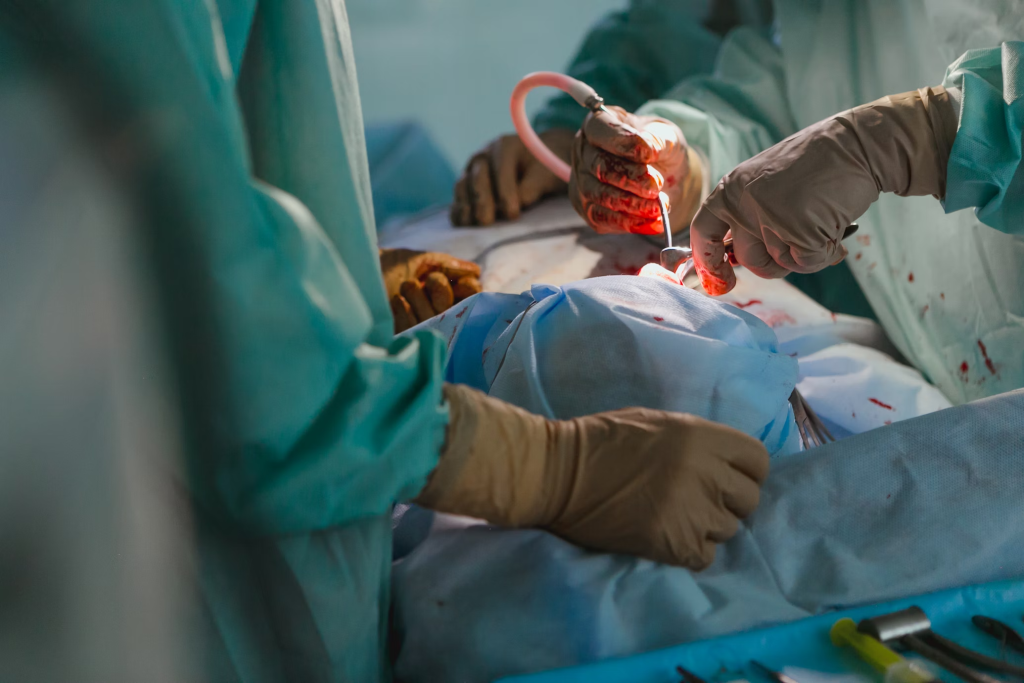Decortication surgery is a medical procedure primarily used to treat various conditions affecting the lungs, including pleural diseases, scarring, and thickening of the pleura, which is the membrane surrounding the lungs.

This type of surgery can significantly improve respiratory function, alleviate pain, and improve a patient’s overall quality of life. Below, we will explore the benefits of decortication surgery in greater detail, particularly for individuals suffering from chronic lung diseases or conditions resulting in pleural fibrosis.
Click That Site For More Details
Key Benefits Of Decortication Surgery
Improved Respiratory Function
One of the primary benefits of decortication surgery is the significant improvement in lung function. Conditions like pleural fibrosis, where the pleura becomes thickened and scarred, can lead to a restrictive form of lung disease. This makes it difficult for the lungs to expand fully, causing shortness of breath, decreased oxygen levels, and overall reduced respiratory capacity.
By removing the fibrous tissue that restricts the lungs, decortication surgery allows the lungs to expand more fully during breathing, improving airflow and oxygen exchange. This can result in marked improvements in lung volumes and gas exchange, providing significant relief to individuals who have experienced chronic breathing difficulties.
Pain Relief
Chronic pain is another key concern for individuals suffering from pleural diseases such as pleuritis or pleural fibrosis. The thickening or scarring of the pleura can lead to discomfort, chest pain, and even difficulty breathing due to the friction between the pleural layers. This pain can significantly reduce the quality of life for patients.
Decortication surgery addresses this pain by removing the fibrous tissue that causes the pleura to become inflamed and stiff. By doing so, the surgical procedure reduces the inflammation and friction between the pleural layers, often resulting in a significant reduction in chest pain and discomfort. Patients who undergo successful decortication surgery often experience a notable improvement in pain levels, which enhances their overall well-being and ability to participate in daily activities.
Prevention Of Further Complications
If left untreated, certain pleural diseases can lead to severe complications. For instance, persistent pleural fibrosis may result in permanent damage to the lung tissue, leading to chronic respiratory failure or the need for a lung transplant in extreme cases. Additionally, scar tissue can obstruct the lung’s ability to properly ventilate, causing further complications such as infections, fluid buildup (pleural effusion), or even lung collapse (pneumothorax).
By performing decortication surgery early in the course of disease progression, doctors can prevent the worsening of these complications. Removing the scar tissue before it causes irreversible damage to the lung or pleura can significantly reduce the risk of lung failure or the need for more invasive treatments in the future.
Improved Quality Of Life
For patients suffering from chronic pleural conditions, daily activities such as walking, climbing stairs, or even simple tasks like eating or dressing can be challenging due to limited lung function and pain. These activities can become even more difficult when the patient is experiencing chronic shortness of breath or lung-related discomfort.
Decortication surgery can restore a significant degree of lung function and reduce pain, making everyday activities more manageable. Patients who undergo successful decortication surgery often report improved energy levels, better stamina, and the ability to engage in physical activities with greater ease. This can greatly enhance their overall quality of life, allowing them to enjoy a more active and fulfilling lifestyle.
Restoration Of Normal Lung Mechanics
The process of decortication restores normal lung mechanics by removing the restrictive layer of fibrous tissue surrounding the lungs. This procedure enables the lungs to fully expand and contract as they should, allowing for better ventilation and oxygenation. In turn, this can prevent the development of other complications, such as atelectasis (collapse of lung tissue), and promote proper lung compliance (the ability of the lung to expand with air).
The restoration of normal lung mechanics is especially beneficial for individuals with restrictive lung diseases, where the lungs are unable to expand fully due to external constraints. After decortication surgery, patients may notice a return to normal lung movement, improving both the mechanics and efficiency of their respiratory system.
Lower Risk Of Chronic Infections
Chronic infections can be a significant issue for patients with pleural fibrosis or other pleural diseases. The thickening and scarring of the pleura may create pockets where fluid or bacteria can accumulate, leading to recurring infections such as pleuritis or pneumonia. These infections can result in ongoing illness, fever, and chest pain and may require repeated hospitalisations.
By removing the fibrous tissue and improving lung function, decortication surgery reduces the likelihood of fluid accumulation and infection. This can decrease the need for antibiotics and hospital visits, improving the patient’s health and overall prognosis. In many cases, patients experience fewer infections after undergoing decortication surgery, as the improved lung function allows for better clearance of pathogens and other irritants from the respiratory system.
Reduced Dependence On Medications
Patients with chronic pleural conditions often rely on medications to manage their symptoms, such as painkillers, anti-inflammatory drugs, or bronchodilators to ease breathing. While these medications may provide some relief, they often come with side effects, and they do not address the underlying problem, which is the restricted movement of the lungs.
Decortication surgery can reduce the need for long-term reliance on medications by directly addressing the cause of respiratory limitations. After surgery, many patients find that they no longer need as much medication to manage pain or breathing difficulties. This can lead to fewer side effects, better overall health, and fewer hospital visits or medical interventions over time.
Minimally Invasive Options
While traditional decortication surgery typically involves a thoracotomy (a large incision in the chest), recent advancements have made minimally invasive techniques, such as video-assisted thoracoscopic surgery (VATS), more common. VATS involves smaller incisions and the use of a camera to guide the surgeon in removing the fibrous tissue.
The minimally invasive approach offers several benefits, including shorter recovery times, less pain, and a reduced risk of complications compared to traditional open surgery. Patients who undergo VATS decortication typically experience a quicker return to daily activities, fewer complications, and a more comfortable post-operative recovery process.
Potential For Long-Term Improvements
In many cases, the benefits of decortication surgery extend beyond immediate post-operative improvements. Over the long term, patients may continue to experience better lung function, reduced pain, and fewer complications related to their pleural condition. This is particularly true for patients who undergo surgery early in the disease process before significant permanent damage has occurred.
By removing the restrictive scar tissue, decortication allows the lungs to function more efficiently over time, potentially delaying the need for more aggressive treatments like lung transplantation. For patients with progressive pleural diseases, decortication may significantly slow down the rate of deterioration, allowing them to lead a longer, healthier life with fewer respiratory limitations.
Conclusion
Decortication surgery offers a range of benefits for individuals suffering from chronic pleural diseases, including improved lung function, pain relief, and an enhanced quality of life. By removing the restrictive scar tissue or fibrous membrane surrounding the lungs, this procedure can significantly improve a patient’s ability to breathe, reduce inflammation, and prevent the further progression of pleural disease.
In addition to providing immediate relief from symptoms, decortication surgery also has long-term benefits, such as reducing the risk of infections, promoting normal lung mechanics, and lowering the dependence on medications.
Whether performed through traditional thoracotomy or minimally invasive techniques like VATS, decortication surgery can be a transformative option for individuals whose lung function has been compromised by pleural fibrosis or other pleural diseases. Overall, decortication surgery is a highly beneficial procedure for those suffering from lung diseases that impair breathing and cause chronic pain, enabling them to experience a better quality of life and a more optimistic outlook for the future.
Frequently Ask Question
Does Decortication Surgery Provide A Permanent Solution?
While decortication surgery can provide significant and long-lasting relief for many patients, it is not always a permanent solution. The benefits of the surgery depend on the underlying condition being treated and how extensive the lung damage is. In cases where the disease is ongoing or progressive, further treatments or surgeries may be needed.
However, for many patients, the surgery provides a significant improvement in lung function and a better quality of life. It can reduce or eliminate symptoms like shortness of breath, pain, and fatigue, especially in patients with conditions like pleural fibrosis.
Are There Alternative Treatments To Decortication Surgery?
Before considering decortication surgery, doctors typically explore less invasive treatments, including medications, chest drainage, or pulmonary rehabilitation. In cases where the pleural disease is caused by an infection, antibiotics or antifungal treatments may be used to control the condition. If the pleura is thickened due to conditions like asbestos exposure, ongoing monitoring and lifestyle changes may be suggested.
However, when these treatments fail to improve symptoms or stop the progression of disease, surgery becomes a more viable option. In some cases, pleurodesis (a procedure to fuse the pleura to the chest wall) may be considered as an alternative.
What Is The Success Rate Of Decortication Surgery?
The success rate of decortication surgery is generally high, especially when the procedure is performed to treat pleural thickening or other restrictive lung diseases. Many patients experience significant improvements in their lung function, reduced symptoms like shortness of breath, and an improved quality of life after recovery.
Success depends on factors such as the extent of lung damage, the patient’s overall health, and how quickly the surgery is performed after diagnosis. In most cases, decortication leads to meaningful improvements, but patients need to have realistic expectations and understand the potential for complications.
